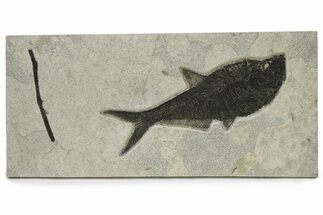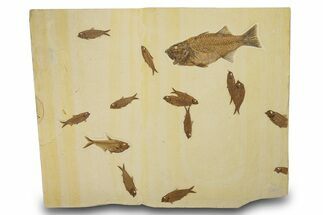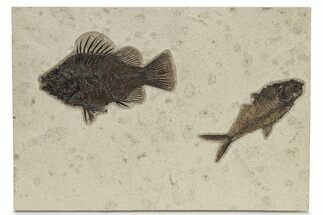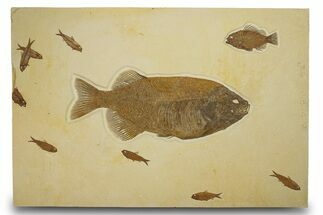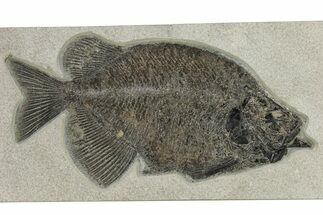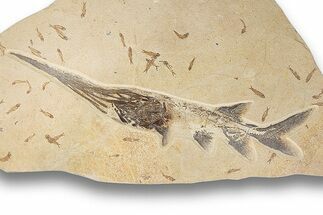This Specimen has been sold.
18.5 & 6" Diplomystus Fish Fossils - Wyoming
These are fossils of a very big, 18.5" long Diplomystus dentatus and also a smaller 6" one collected from the Eocene aged, Green River Formation of Wyoming. The fish are extremely detailed with dark preservation on a single slab of rock. There is a small portion of repair done to the lower right corner to give the piece a sharp corner. The piece is approximately 46.75 x 17.5" and it has been backed with hardie board to strengthen the stone and is roughly 1" thick. It would look wonderful framed or just mounted on a wall. If you would like us to mount a hanging bracket on the back please let us know.
Diplomystus is an extinct genus of freshwater, ray-finned predators that are distantly related to modern herrings and sardines. Diplomystus has a distinctive jaw that protrudes aggressively outward from the mouth at an angle that allowed it to feed in surface waters and devour such prey as the smaller, schooling Knightia.
50 million years ago in the Eocene (55.8 mya to 33.8 mya), D. dentatus thrived in lakes fed by the Uinta and Rocky Mountain highlands. D. dentatus is uniquely entombed in the fine-grained lime mud of Fossil Lake.
The anoxic conditions at the bottom of Fossil Lake slowed bacterial decomposition, prevented scavengers from disturbing corpses, and, most interestingly, suffocated creatures that ventured into the oxygen-starved aquatic layer. The result is a miraculous exhibition of Eocene biota in a subtropical aquatic community within sycamore forests, teeming with creatures such as freshwater stingrays, dog-sized horses, menacing alligators, early flying bats, and one of the first primates.
By the end of the Eocene, Earth developed icehouse climate characteristics and had a change in atmospheric chemistry. The effects of bolide impacts may also have contributed to the eventual loss of flora and fauna at once verdant latitudes.
Today the wonderfully preserved fossils of Diplomystus and other Fossil Lake fauna are collected in several private quarries around Kemmerer, Wyoming. The best preserved fish fossils come from the coveted 18 Inch Layer. This layer is collected at night under high-powered lights, enhancing the faint signs of fish under the surface indicating underlying fossils. These “ghosted” fish then must go through many hours of manual preparation to remove the overlying rock and reveal the Green River fauna in all of its glory.
50 million years ago in the Eocene (55.8 mya to 33.8 mya), D. dentatus thrived in lakes fed by the Uinta and Rocky Mountain highlands. D. dentatus is uniquely entombed in the fine-grained lime mud of Fossil Lake.
The anoxic conditions at the bottom of Fossil Lake slowed bacterial decomposition, prevented scavengers from disturbing corpses, and, most interestingly, suffocated creatures that ventured into the oxygen-starved aquatic layer. The result is a miraculous exhibition of Eocene biota in a subtropical aquatic community within sycamore forests, teeming with creatures such as freshwater stingrays, dog-sized horses, menacing alligators, early flying bats, and one of the first primates.
By the end of the Eocene, Earth developed icehouse climate characteristics and had a change in atmospheric chemistry. The effects of bolide impacts may also have contributed to the eventual loss of flora and fauna at once verdant latitudes.
Today the wonderfully preserved fossils of Diplomystus and other Fossil Lake fauna are collected in several private quarries around Kemmerer, Wyoming. The best preserved fish fossils come from the coveted 18 Inch Layer. This layer is collected at night under high-powered lights, enhancing the faint signs of fish under the surface indicating underlying fossils. These “ghosted” fish then must go through many hours of manual preparation to remove the overlying rock and reveal the Green River fauna in all of its glory.
SPECIES
Diplomystus dentatus
LOCATION
Kemmerer, WY
FORMATION
Green River Formation
SIZE
18.5", 6" Long on 46.75x17.5" matrix
CATEGORY
SUB CATEGORY
ITEM
#18058
We guarantee the authenticity of all of our
specimens. Read more about our
Authenticity Guarantee.
specimens. Read more about our
Authenticity Guarantee.
 Reviews
Reviews

